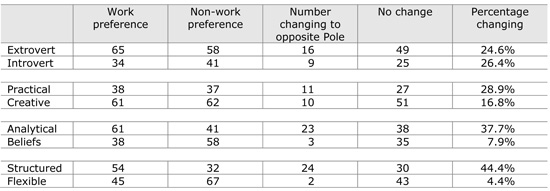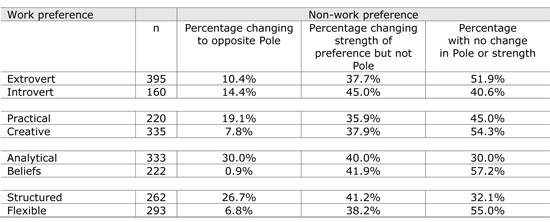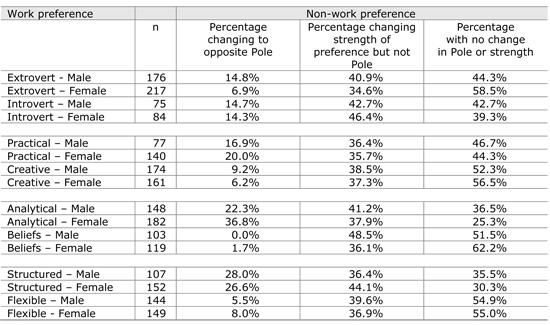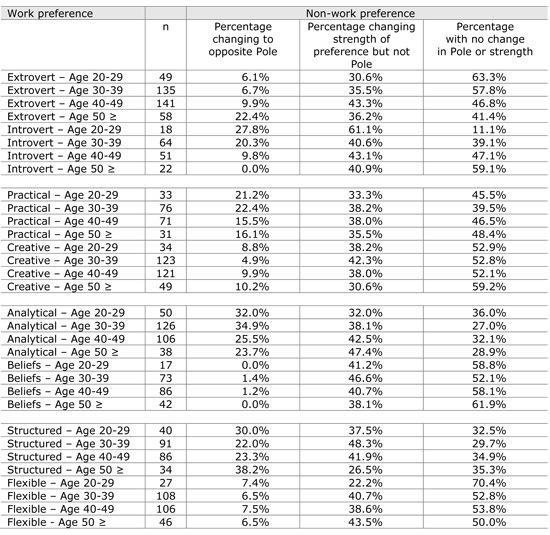Work and Non-Work Study
Introduction
A large range of instrumentation is now being used in industry, commerce and government to assess personality, managerial style and to predict work behaviour. Many of these instruments were never designed for such a purpose. They are used because they are available, convenient and well marketed. However the results obtained and the feedback given have to be interpreted in the context of the use for which each instrument was initially designed. This section explains the difference between work specific and generalized instruments and outlines guidelines for their use in human resources.
Understanding Behaviour at Work
Over the last thirty years in particular, various efforts have been made to gain a better understanding of why people behave the way they do. Measures to achieve this have been based on a wide range of theories and research. Too often however, the measures that have been created and tested with specific samples in specific situations are then used in other contexts without considering their utility and applicability, let alone their validity in the new situation.
This is no more evident than in the world of work. Instruments that were originally designed for testing children, prisoners, or people in medical situations are introduced into the workplace with the assumption they will be equally valid in their measurement and in the feedback provided. Likewise instruments that have been devised for general assessment of say extroversion or neuroticism are transferred to the work situation without evidence of face, concurrent, or predictive validity. There are considerable dangers in this, not only because the staff involved will complete the instrument in the context of their job but also because the feedback provided may not be appropriate and in many cases may be misleading.
When Cattell (1965) first developed the 16PF it was not specifically designed for the work situation. Indeed it is a non-situation specific instrument. However, it is now used widely in employment situations. Likewise the Myers-Briggs Type Indicator®1 (MBTI®) assessment (1976) was originally developed to assist young people with life choices based on Jung's type theory (1923). This is now used widely and often indiscriminately in employment situations ranging right through from selection to training and work adjustment counseling.
There are many other instruments that are used with little regard for their specific context validity. We are therefore of the view that there is a need to look at all psychological instruments within the sociological context in which they will be used.
This is a view clearly articulated by George Kelly (1955) whose work on personal construct theory helps bridge the gap between the individual and the situation. Kelly's view was that a person experiences a situation and has feelings about the events which lead to an interpretation and a structure of meaning. These guide a person's behaviour until such time as it is modified by further experience. Therefore a person establishes a number of constructs to explain and relate what is happening around them.
This approach is similar to the work of Carl Jung (1923) who considered that individuals develop their understanding through particular approaches to situations based upon their own predisposition for interacting with others. As a result Jung said people develop differently within a framework of psychological types.
In our work we have built on these ideas and constructed measures which take into account both the psychological (who am I?) issues and the sociological (what is the context?) issues. As a result we have developed the Team Management Systems instruments to help people in the work situation gain self-understanding and the understanding of others (Margerison and McCann, 1991).
Study 1
A sample of 99 Training and Development managers were asked to describe their preferences for one pole of each of the four Team Management Profile (TMP) constructs, both at work and outside of work. The different patterns that emerged as people's preferences changed between work and non-work settings are reported in the table below. Please note that rounding errors may occur.

Table 1. Work and non-work preferences (n=99)
It seems that work, at least for this group of managers, required a more Analytical rather than Beliefs-based preference, and more Structured than Flexible preference. The workplace can be seen therefore as placing contracts on people's preferences.
Moreover, Table 1 suggests that preferences are not consistent for everyone. By definition if you give people a choice then some people prefer to see themselves acting in different ways in different situations. This supports our view that situational measures as far as work are concerned are essential to gain relevant feedback.
This lines up with the work of Kabanoff (1980) who proposed that people's orientation in work and non-work settings can be different.
Study 2
A sample of 555 respondents were asked to describe their preferences for one pole of each of the four Team Management Profile Questionnaire constructs, both at work and outside of work. Please note that this sample includes data from the ‘Study 2’ sample of 282 respondents reported in TMS Research Manual: 3rd Edition. The results of the final sample are reported in Table 2. Please note that rounding errors may occur.
This sample included respondents aged 20 to 68 from 26 countries. The largest groups for country where the respondent works were Australia (62%), Germany (13%), England (7%), and the USA (6%). For age group the largest areas were 30-39 (36%) and 40-49 (35%). In terms of profession data, 36 areas were recorded for the sample with the largest being HR/Trainer (62%) and Psychologist (4%).
To interpret Table 2, look at the column 'Work preference'. This shows the number or respondents recording their preferences at work. For example 262 people indicated they preferred 'structure' in the way they organized themselves and others. Outside of work 26.7% of these respondents preferred a 'flexible' environment. 41.2% still preferred 'structure' outside of work but recorded a significant difference in their scores between the two situations. 32.1% of people had no significant change in preference. In other words their work and non-work preferences were the same.
This data again suggests that preferences are not consistent for everyone and supports our view that situational measures as far as work are concerned are essential to gain relevant feedback, as the workplace can be seen as placing constraints on people's preferences.
Of particular interest are the Analytical and Structured scores. Most of the norm data show a skewness towards Analytical and Structured preferences with the median value for the worldwide sample of 303711 being 12 for Analytical and 5 for Structured. Table 2 suggests that much of this skewness can be explained by respondents who are Beliefs-oriented and Flexible in the non-work environment changing to the opposite poles when they go to work. Most likely this is an adaptation to align preferences to the ‘accepted’ culture of many organizations, that is analytical and structured.
Table 2 shows the work preference skewness towards Analytical with 60% of the sample having an 'A' score and 40% having a 'B' score. However the non-work preference is reversed with 42% having an Analytical preference but 58% with a Beliefs preference.
On the S-F scale the work preference split is 47% towards 'S' and 53% towards 'F'. In the non-work situation it is 38.2% towards 'S' and 61.8% towards 'F'. From this we can conclude that the bias towards 'AS' preference at work is counterbalanced by a bias towards 'BF' preference outside work. This is convincing evidence that people's preferences at work can be substantially different from their preferences outside work.

Table 2. Work and non-work preferences for the total sample (n=555)
Comparative Samples
Table 3 looks at the results recorded by gender. An interesting difference is that between men and women who have Analytical work preferences. 36.8% of women revert to ‘beliefs’ preferences outside of work compared with 22.3% for men. Only 25.3% of women indicated no change in pole or strength between the two environments. This may reflect the need for women to ‘play’ different roles in order to meet the different demands placed on them in the two largely different environments.

Table 3. Work and non-work preferences for gender samples: Male (n=251) and Female (n=301)
Table 4 looks at the results recorded for the age group samples.
The results should be interpreted cautiously as the samples ‘Age 20-29’ and ‘Age 50 >’ both have less than 100 respondents. In general though, the trends in the Analytical-Beliefs and Structured-Flexible data mentioned in the Table 2 analysis, seem to be fairly uniform across age groups.
However, it is interesting to note the age trends in the Extrovert-Introvert analysis. 22.4% of the Extrovert work preference group aged 50 >shift to being introverted outside work, compared with an average of approximately 8% for those in the lower age groups. This may indicate that, for those who are introverted outside of work, it takes some time to develop an extroverted work preference.
Significant differences also occur for the Introvert work preference groups aged 20-39, where approximately 22% shift to being extroverted outside work, compared with around 7% for the groups aged >=40. This may reflect the influence of job demands on younger employees in more junior roles, where they may not be able to apply their preference for non-work extroversion due to lack of specific task skills or a lack of confidence, and are therefore comfortable with an introverted work preference. As they develop these skills and/or confidence, they may choose to move to jobs that allow their extroversion to flourish and therefore would appear later in one of the Extrovert work preference age groups. Those in the older introvert work preference group may have chosen work to match their preferences and therefore there is less need for them to change preferences in the non-work situation. The important point, though, is that there are significant differences in Extroversion and Introversion between the work and non-work situations.

Table 4. Work and non-work preferences for age group samples: Age 20-29 (n=67), Age 30-39 (n=199), Age 40-49 (n=192) and Age 50 ≥ (n=80)
Conclusion
The Team Management Systems instruments are all examples of those that have been especially developed for use in the work situation. Therefore it is as unwise to use them outside of that context as it is to use other instruments that have been devised for non-work assessment in situations at work. Increasingly we need more instruments that are specifically focused on the needs of people at work and which provide useful and relevant feedback to help people improve their performance. To extrapolate results from the non-work situation to the work situation and vice versa is unwise.
Footnotes:
1 ® MBTI, Myers-Briggs, and Myers-Briggs Type Indicator are trademarks or registered trademarks of the Myers-Briggs Type Indicator Trust in the United States and other countries.
References:
- Cattell, R.B., (1965), The Scientific Analysis of Personality, Penguin.
- Jung, C., (1923), Psychological Types, Routledge and Kegan Paul, London.
- Kabanoff, B., (1980), Work and Non Work: A Review of Models, Methods and Findings, Psychological Bulletin, Vol. 88, No. 1, pp. 60-77.
- Kelly, G.A., (1955), The Psychology of Personal Constructs, Norton, New York.
- Margerison, C.J., and McCann, D.J., (1990), Team Management: Practical New Approaches, Mercury Press.
- McCann, D.J., & Mead, N.H.S., (Eds.), (2003), Team Management Systems Research Manual: 3rd Edition, Team Management Systems, Brisbane, and York.
- Myers-Briggs, I., (1976), The Myers-Briggs Type Indicator, Consulting Psychologists Press.
Copyright © Team Management Systems. All rights reserved.

